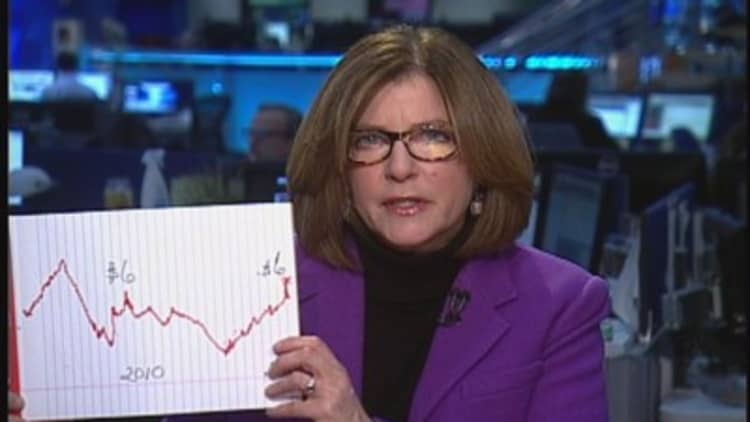
Natural gas futures spiked on forecasts of another arctic air blast descending on North America and unseasonably cold temperatures in March.
March futures soared to settle about 11 percent higher, at $6.149 per million BTUs—a five-year high. Natural gas is up nearly 44 percent since Jan. 1, after unusually cold weather sparked record demand and forced a massive draw-down in storage.
"Are we going to $15 again? No; $6 yes, to $7, yes—but at that point, fracking will take off," said Dennis Gartman, publisher of The Gartman Letter. Natural gas prices have been moderate and hit a low in the $1.90 range in 2012, as U.S. production rose.
Hydraulic fracturing, or fracking, has enabled the drilling of previously unattainable gas and has led to forecasts of 100 years worth of supplies in the ground in the U.S.
On Wednesday, weather service WSI said that another "polar vortex" could be heading to the U.S. later this week and into next week. Arctic air is expected to descend Friday and make its way across the northern Plains and Upper Midwest before spreading south and east.
(Read more: )
The European Centre for Medium-Range Weather Forecasts shows that temperatures will be colder than originally thought into the second week of March.
As late as Tuesday, those models had shown temperatures moderating, but latest forecasts are forcing meteorologists to revise their predictions.
WSI, which advises Wall Street clients trading weather-sensitive stocks and commodities, is now calling for colder weather deeper into next month.
WSI Senior Meteorologist Dan Leonard told CNBC that "our outlook had already been hedging in the colder direction anyway, but the overnight trends boosted forecast confidence this morning."
The service expects daytime temperatures in cities including Chicago, Minneapolis and Des Moines, Iowa, to be in the teens and 20s, and possibly the single digits. Overnight temperatures are expected in the single digits, with subzero temperatures likely.
(Read more: Compressed nat gas may not be all that green)
The March natural gas contract expires next week, and traders expect the April contract, now below $5 per million BTU, to push higher as well.
"The March to April spread today has jumped out to $1.13," said Gene McGillian, analyst with Tradition Energy.
The Energy Information Administration releases natural gas inventory data at 10:30 a.m. ET Thursday.
"The withdrawals are eye-popping," said John Kilduff of Again Capital. "They've been dramatic every week. I'm looking for another 250 billion cubic feet."
The 1.6 trillion cubic feet in storage could be reduced to less than 1 trillion cubic feet by the end of the heating season at the end of March, he said. "One trillion cubic feet is low; that is very supportive for the market. Our storage level is already what we ended the season with last year."
Kilduff said prices are not likely to remain at the current elevated level once heating season winds down, but traders will then watch to see if storage can be rebuilt. An unusually warm spring or summer could boost air-conditioning demand, putting pressure gas supplies in storage for the next winter heating season.
"This year, with this cold weather and demand levels, there's a question of whether these oversupply years are over and we're going to reach an equilibrium ... to $7," McGillian said.
He expects some energy producers to switch to coal if they can should prices stay high.
"You're going to see a much firmer cash price, and that's going to transfer into higher futures prices," McGillian said. The amount of gas in storage is now at a 10-year low, he added.
(Read more: Natural gas should stay cheap for long time—study)
"The largest amount of gas we put in the ground in the last 15 years was 2.7 trillion cubic feet," he said. "If we get down to 1 trillion cubic feet and we see the maximum amount of gas we put in the ground … that would be pretty satisfactory."
Jeff Grossman, president of BRG Brokerage in New York, told CNBC the commodity is approaching its top and could soon fall sharply.
"We have a possibility of this market reaching its goals and probably selling off," Grossman said on "Power Lunch." "This market has gone way above what most people even considered normal range here and we now have a point here where no one is willing to sell this market. Usually when that happens, the market is ready for a good sell off."
As for consumers, a double digit one-day spike in natural gas futures won't necessarily translate into significantly higher home heating bills. For months, home heating costs have been forecast to have risen considerably from the winter of 2012-2013.
Natural gas prices had been so low in early 2013, forecasters were anticipating that natural gas futures and residential natural prices would be significantly higher this winter than last.That's exactly what has occurred. Most utilities and consumers lock in prices in the fall or start of winter so they will not feel much of an impact of the rise in natural gas futures and spot market prices for natural gas. However, insome regions of the country, those who pay a monthly variable rate will see a significant spike in their home heating and utility bills.
For this winter, the EIA has predicted the increase in residential natural gas prices will range from a 10 percent increase in the West to a 15 percent increase in the Northeast. In its most recent Winter Fuels Outlook issued on February 11, the EIA said it expects households heating with natural gas to spend an average of $80 (13 percent) more this winter than last winter.
—By CNBC's Patti Domm. Follow her on Twitter @pattidomm.


